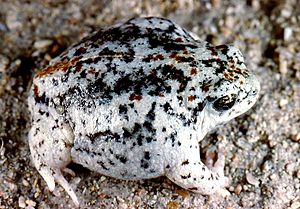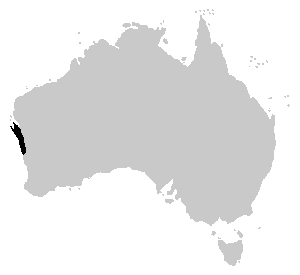Sandhill frog facts for kids
The northern sandhill frog (Arenophryne rotunda) is a small, burrowing frog that lives along the coast of Western Australia. It was once thought to be the only frog of its kind in the Arenophryne group. However, in the early 2000s, another frog called the southern sandhill frog was found near Geraldton, Western Australia, in Kalbarri National Park.
Quick facts for kids Sandhill frog |
|
|---|---|
 |
|
| Conservation status | |
| Scientific classification | |
 |
|
| Distribution of Arenophryne (in black). |
What Does the Northern Sandhill Frog Look Like?
The northern sandhill frog is a small, round frog. It can grow up to 33 millimeters (about 1.3 inches) long. It has short, strong legs because it burrows into the sand. Its back is a mix of dark grey, white, or pale brown colors. It has small bumps and ridges all over its skin. You might also see small, bright red or green spots on its back. Its belly is a dull white color. The frog's head is small and shaped like a triangle, and its body is flat. You cannot see its eardrum (tympanum).
How Do Sandhill Frogs Live and Behave?
Sandhill frogs are quite special among Australian ground frogs. Most burrowing frogs in Australia dig backwards into the ground. But the sandhill frog, along with the turtle frog (Myobatrachus gouldii), burrows head-first! To do this, both frogs have small heads and strong front legs.
These frogs live in sandy areas called sand dunes along the coast of Western Australia. Their home stretches from Shark Bay in the north to Kalbarri National Park in the south and Cooloomia in the east. This area doesn't have much standing water because the sand quickly soaks it up. However, the sand stays moist just a little below the surface. During the day, the sandhill frog digs into this moist sand layer to avoid drying out. At night, it comes out to hunt. Their main food is ants.
Northern Sandhill Frog Reproduction
During March and April, the male frogs call out to attract females. They can call from above or below the sand. Once a pair meets, the male and female will burrow together. As the dry season makes the sand drier, the frogs keep digging deeper to stay in the wet layer. They can dig down as far as 80 centimeters (about 2.6 feet)!
The female frog lays up to eleven eggs underground. These eggs develop directly into small frogs, skipping the tadpole stage completely. The adult frogs stay underground for at least five months.


